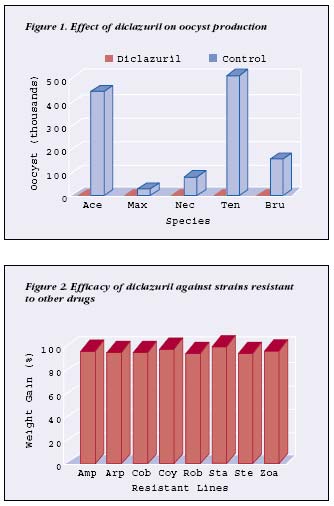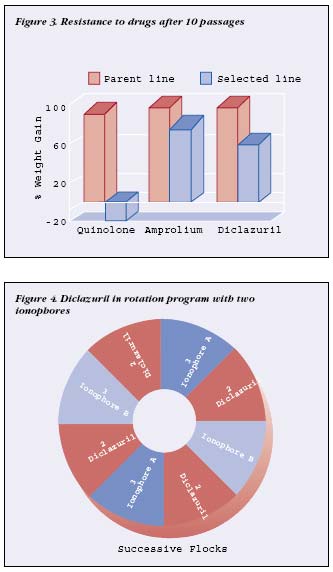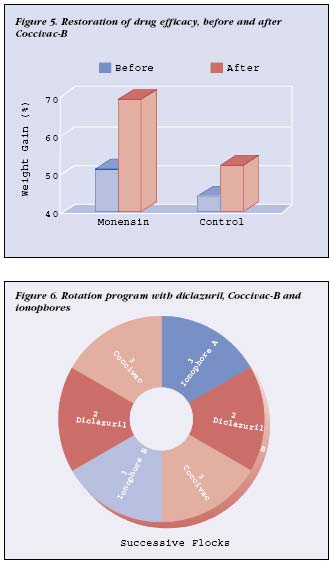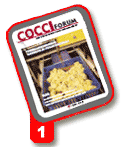Technically Speaking
Dr. H. David Chapman, University of Arkansas, discusses new rotation strategies

Dr. H. David Chapman Department of Poultry Science University of Arkansas |
Outbreaks of coccidiosis "recognized
by obvious intestinal
lesions and excessive mortality
"occur less frequently in modern
poultry operations than they did in the
past. Nevertheless, subtle effects of the
disease, such as reduced growth rate
and impaired feed conversion, continue
to reduce the performance and
profitability of commercial birds.
Over the years, sound management
practices, sanitary procedures and a
broad range of anticoccidial feed additives
have all helped to control coccidiosis.
Still, Eimeria parasites remain
widespread in U.S. poultry flocks,
mostly because the parasites have
developed resistance to most in-feed
coccidiostats after prolonged usage. It
is therefore important to continually
seek improved methods of coccidiosis
control.
Managing Immunity
Traditional approaches to coccidiosis
control aim to identify the most effective
drug in order to achieve optimal
control of the disease. In the past, a
succession of new drugs was introduced
enabling a producer to select
the most effective agent. Few truly
new products have appeared in the
last decade, however, and it has
become increasingly difficult to benefit
from the "new drug effect" usually
seen with novel anticoccidials.
In recent years, an alternative
approach involving the use of drugs
that allows immunity to develop has
become more popular. Recent research
has shown that although drugs such as
salinomycin do not prevent the acquisition
of immunity, this process takes
time and solid immunity is not
acquired until birds are 6 to 7 weeks
of age.
The development of immunity
under these circumstances depends
upon the accidental exposure to infective
oocysts in the environment.
Acquisition of immunity also depends
on the frequency and duration of
exposure to infection, the species of
Eimeria present, and environmental
and management factors.
Natural exposure to infection cannot
be guaranteed, so controlled exposure
by intentional immunization
(using live coccidiosis vaccines) is
more appropriate if immunity is
desired. The recent introduction of a
new method of coccidiosis vaccination
"spray cabinet in the hatchery -
has made this more practicable for
broiler production.
Reliance upon immunity development
in medicated birds has the disadvantage
that reduced performance due
to subclinical coccidiosis may occur if
birds are exposed to high levels of
infection early in life before immunity
has developed.
New Tools, New Strategies
 |
The U.S. poultry industry's newest coccidiostat,
diclazuril (Clinacox, Schering-
Plough Animal Health), has a unique
mode of action and provides broiler
operations with an alternative method
of control. The synthetic anticoccidial
is effective against all species of
Eimeria as evidenced by greater suppression
of lesions in the intestines
compared with other drugs. Diclazuril
is also able to completely suppress
oocyst production (Fig. 1), thereby
reducing the risk of subclinical infection.
It is therefore ideal for reducing
infection levels or "cleaning-up" commercial
houses.
When used in rotation programs
with other anticoccidials, diclazuril will
not only improve efficacy, but its
"clean-up" effect should help improve
the efficacy of other drugs. This is
important because other feed additives
used for coccidiosis control -
ionophorous antibiotics such as salinomycin,
monensin, narasin and semduramicin
"belong to the same family
of drugs and have a similar mode of
action. As a result, strains of coccidia
resistant to one drug show reduced
sensitivity to the others.
In order to suppress these resistant
strains, it is necessary to use a drug
with an unrelated mode of action.
Diclazuril is effective against
ionophore-resistant strains and strains
resistant to various "chemical" drugs
such as amprolium, clopidol, robenidine,
halofuginone and zoalene (Fig.
2). Ideally, diclazuril should be used
with the flock following litter removal,
as this should help reduce the numbers
of any drug-resistant organisms.
Judicious Use
 |
The consequences of feeding the same
anticoccidial for prolonged periods are
well known and almost always result
in a progressive decline in efficacy.
This has been demonstrated with the
ionophore monensin, where strains of
E. acervulina isolated from breeder
farms (where the drug had never been
employed) were more sensitive to the
drug than strains from broiler farms
with a long history of ionophore
usage.
Like ionophores and other established
coccidiostats, diclazuril has the
potential to become less effective
when used continuously. It is therefore
important to understand its limitations
and use it judiciously.
Trials were conducted to compare
E. tenella resistance buildup to
diclazuril with a quinolone (to which
resistance develops rapidly) and
amprolium (to which resistance develops
slowly). After 10 generations, a
reduction in sensitivity to diclazuril
was observed (Fig. 3). However, the
rate of development of resistance was
more comparable with amprolium
than with the quinolone.
It is clear that resistance to diclazuril
will develop with prolonged use,
just as it has to other coccidiostats.
However, using the new anticoccidial
responsibly will help to preserve the
product's "clean up" power.
Alternating coccidiostats (rotation
programs) has been practiced for
many years, but the approach has
been more empirical than systematic.
For best results, diclazuril should be
used for no more than two successive
flocks before rotating to an ionophore
or a chemical/ionophore shuttle program;
e.g., nicarbazin followed by salinomycin
in starter and grower feeds
(Fig. 4). Rotating diclazuril with a coccidiosis
vaccine such as Coccivac-B
(Schering-Plough Animal Health) will
also help to "rest" feed additives and
preserve their effectiveness.
Diclazuril: Where It Fits
Should diclazuril be used in the starter
feed, the grower feed or in both?
It is important to include diclazuril
in the starter ration to reduce the
build-up of oocysts in the litter.
Although lesions due to Eimeria are
not often seen before 3 weeks of age,
this is the period when the initial
infection and multiplication of the parasite
occurs.
Diclazuril can also be included in
the grower ration because this is the
period when the pathogenic effects of
coccidiosis are most likely. Another
reason to include diclazuril in both
feeds is to eliminate any resistant
strains "a goal that cannot be readily
achieved in shuttle programs where a
chemical is used only in the starter
feed. This is because any oocysts of a
"resistant" strain can survive in the litter
for the brief period that a chemical
is present in the starter feed. Published
data suggest that when diclazuril is
included in the grower feed, performance
is similar to or better than other
ionophore programs.
Rotation With a Vaccine
Coccidiosis vaccines have been
employed for many years for the
immunization of replacement pullets
and broiler breeders. Over the past
two years, however, the option for
spray cabinet administration for one
live vaccine, Coccivac-B, has caused
usage in broilers to increase significantly.
Published data have shown
performance of vaccinated birds to be
statistically equivalent to conventional
coccidiostats in flocks 35 days of age
or older.
 |
It should be noted that Coccivac-B
contains strains of Eimeria that were
isolated many years ago and are inherently
sensitive to in-feed coccidiostats.
The product can therefore be used to
replace wild, resistant strains of coccidia
with the vaccinal ones. It has
been demonstrated that the use of
Coccivac-B can restore the sensitivity
to drugs in farms where extended
usage of coccidiostats has selected for
resistance.
For example, in a study of the efficacy
of monensin against isolates of
Eimeria obtained from broiler flocks
after vaccination with Coccivac-B (Fig.
5), medicated birds showed improved
weight gain and produced fewer parasite
oocysts in their droppings.
Alternating drugs and vaccines may
therefore be advantageous since it
could result in a restoration of sensitivity
to anticoccidial drugs.
Getting More Creative
The growing interest in coccidiosis
vaccination and the arrival of diclazuril
present new options for managing the
disease and reducing the potential for
resistance.
For example, following use of an
ionophore such as salinomycin, feed
diclazuril for two cycles and follow
with Coccivac-B for the next two
cycles (Fig. 6). Diclazuril would
"clean-up" the broiler house and subsequent use of the vaccine should
then repopulate the house with drugsensitive
parasites. It should then be
possible to return to salinomycin or
other ionophore. An additional benefit
of this approach is that use of the vaccine
should prevent the emergence of
resistance to diclazuril.
So far evidence to prove that rotation
programs will improve the efficacy
of anticoccidial drugs in the longer
term has not been obtained.
Nevertheless, adoption of novel strategies
is important because few new
effective drugs will be available in the
future for the control of coccidiosis.
Source: CocciForum Issue No.1, Schering-Plough Animal Health.







